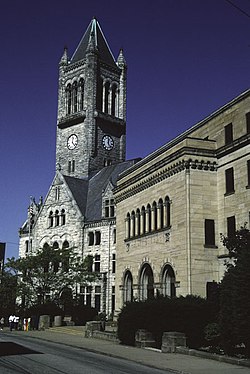Uniontown Downtown Historic District
Uniontown Downtown Historic District | |
 Fayette County Courthouse, May 1999 | |
| Location | Roughly Main St., between Court St. and Mill St., Uniontown, Pennsylvania |
|---|---|
| Coordinates | 39°54′04″N 79°43′33″W / 39.90111°N 79.72583°W |
| Area | 31.3 acres (12.7 ha) |
| Architectural style | Moderne, Late Victorian, Georgian |
| NRHP reference No. | 89000357, 03000036 (Boundary Increase)[1] |
| Added to NRHP | May 19, 1989, February 14, 2003 (Boundary Increase) |
Uniontown Downtown Historic District is a national historic district located at Uniontown, Fayette County, Pennsylvania. The district includes 113 contributing buildings and 1 contributing site in the central business district of Uniontown. Most of the contributing buildings were built between 1881 and 1932, and are representative of a number of popular architectural styles including Classical Revival, Moderne, Late Victorian, and Georgian. Twenty-two buildings date between 1811 and 1860. Notable buildings include the Fayette Bank Building (1902), Thompson-Ruby Building (1900), Highland House (1890), State Music Hall (1922), Exchange Hotel (1891), Galltin Apartments (1929), Gallatin Bank Building (1924), Federal Building (1930), Fayette County Courthouse (1892), County Building (1927), Central School (1916), and St. Peter's Episcopal Church (1884).[2]
It was added to the National Register of Historic Places in 1989, with a boundary increase in 2003.[1]
References
- ^ a b "National Register Information System". National Register of Historic Places. National Park Service. July 9, 2010.
- ^ "National Historic Landmarks & National Register of Historic Places in Pennsylvania" (Searchable database). CRGIS: Cultural Resources Geographic Information System. Note: This includes Walter J. Storey (November 1988). "National Register of Historic Places Inventory Nomination Form: Uniontown Downtown Historic District" (PDF). Retrieved 2012-01-29. and Charles H. Uhl (October 2002). "National Register of Historic Places Inventory Nomination Form: Uniontown Downtown Historic District (Boundary Increase)" (PDF). Retrieved 2012-01-29.
- Georgian architecture in Pennsylvania
- Moderne architecture in Pennsylvania
- Historic districts in Fayette County, Pennsylvania
- Uniontown, Pennsylvania
- Historic districts on the National Register of Historic Places in Pennsylvania
- National Register of Historic Places in Fayette County, Pennsylvania
- Fayette County, Pennsylvania Registered Historic Place stubs




